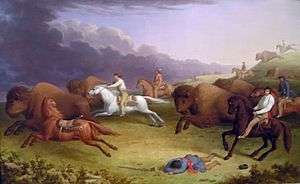Half-breed

Half-breed is a term, now considered derogatory, used to describe anyone who is of mixed race, though it usually refers to people who are half Native American and half European or white.[1] Half-breed is the English version of the French word "métis".
Use by governments

In the 19th century the United States government set aside lands in the western states for people of American Indian and European or European-American ancestry known as the Half-Breed Tract. The Nemaha Half-Breed Reservation was established by the Treaty of Prairie du Chien of 1830.[2] In Article 4 of the 1823 Treaty of Fond du Lac land was granted to the "half-breeds" of Chippewa descent on the islands and shore of St. Mary's River near Sault Ste. Marie.[3]
During the Pemmican War trials that began in 1818 in Montreal regarding the destruction of the Selkirk Settlement on the Red River the terms Half-Breeds, Bois-Brulés, Brulés and Métifs were defined as "Persons descended from Indian women by white men, and in these trials applied chiefly to those employed by the North-West Company".[4]
The Canadian government used the term half-breed in the late 19th and early 20th century for people who were of mixed Aboriginal and European ancestry.[5] The North-West Half-Breed Commission established by the Canadian government after the North West Rebellion also used the term to refer to the Métis residents of the North-West Territories. In 1885 children born in the Northwest of Métis parents or "pure Indian and white parents" were defined as half-breeds by the commission and were eligible for "Half-breed" Scrip.[6][7][8]
In Alberta the Métis formed the "Halfbreed Association of Northern Alberta" in 1932.[9]
Geographical names
- Halfbreed Lake National Wildlife Refuge and Halfbreed Lake in Montana
In popular culture
- The villain of Mark Twain's novel, The Adventures of Tom Sawyer, is a Native American-European-American man named "Injun Joe"; he is referred to as a "half-breed", often together with a derogatory adjective, such as "stinking," and has a violent and homicidal personality, which is attributed to his heritage.
- Several Western films feature characters with both White American and Native American blood, who are more often than not referred to as "half-breeds" as an insult; such characters include "Keoma" from the eponymous film, and "Chato" from Chato's Land.
- "Half-Breed" is a song recorded by Cher and released as a single in 1973. On October 6, 1973, it became Cher's second U.S. number one hit as a solo artist, and it was her second solo single to hit the top spot in Canada on the same date.[10]
Further reading
- Hudson, Charles. Red, White, and Black: Symposium on Indians in the Old South, Southern Anthropological Society, 1971. ISBN 9780820303086.
- Perdue, Theda. Mixed Blood Indians, The University of Georgia Press, 2003. ISBN 0-8203-2731-X.
See also
Notes
- ↑ "The free dictionary (half-breed)". Retrieved 2014-03-23.
- ↑ David J. Wishart (2004). Encyclopedia of the Great Plains. U of Nebraska Press. p. 573. ISBN 0-8032-4787-7.
- ↑ United States; Richard Peters (1848). The Public Statutes at Large of the United States of America from the Organization of the Government in 1780, to March 3, 1845: Arranged in Chronological Order. With References to the Matter of Each Act and to the Subsequent Acts on the Same Subject, and Copious Notes of the Decisions of the Courts of the United States Construing Those Acts, and Upon the Subjects of the Laws .. C.C. Little and J. Brown. p. 291.
- ↑ Amos, Andrew (1820). "Report of trials in the courts of Canada, relative to the destruction of the Earl of Selkirk's settlement on the Red River With observations". Saskatoon Gen Web. London: John Murray. Retrieved 2015-02-08.
- ↑ "Library and Archives Canada-Métis Scrip Records (Use of term Half Breed)". Retrieved 2015-01-23.
- ↑ "Library and Archives Canada-Métis Scrip Records (Commissions-North-West Half-Breed Commissions)". Retrieved 2015-01-23.
- ↑ "Northwest "Half-breed" Scrip". Métis National Council Historical Database. Retrieved 2015-01-23.
- ↑ "Our Legacy-Canada. Department of Northern Affairs and National Resources (Grants to half-breeds of the Province of Manitoba and the North West Territories in respect of the extinguishment of the Indian Title, 1870-1925.) pp. 1 to 16". University of Saskatchewan. Retrieved 2015-01-23.
- ↑ "Councillors of the Halfbreed Association of Northern Alberta 1932" (PDF). Retrieved 2015-05-21.
- ↑ "Top Singles", RPM, Volume 20, No. 8, October 06 1973, Library & Archives Canada
External links
- Murray Parker: "The Half-breed Savage/ Quanah Parker", Texas Escapes
- "Half-breed", Dictionary